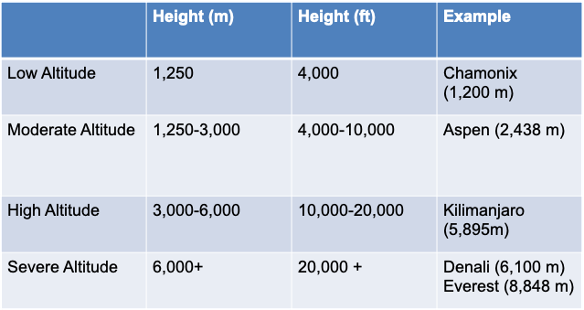Altitude 101
You might encounter driving rain. There could be sideways sleet. Maybe there’s a chance of snow? Or perhaps searing heat will burn down on you from above. There’s a lot that’s unknown about the environmental stressors you’ll encounter on expedition. However, there is one certainty. Altitude.
The thin air is a challenge for those on their first foray to altitude and experienced mountaineers alike, but to those relatively new to high altitude expeditions it is the great unknown and, as a result, many would-be summiteers’ greatest fear. However, knowledge is power, and knowing what to expect can make things seem far less daunting.
What is Altitude?
We’d classify anything over ~1200m as being ‘altitude’ in that it starts to have some effect on the body. For most expeditions, that means even your starting height would be considered as ‘at altitude.’

To understand what that means for the body, we first need to have a quick physics lesson. Put simply, the higher you go, the thinner the air becomes. Quite literally, oxygen molecules in the air are more spaced out at high altiutde. This means that with each breath you take in less oxygen. The greater the altitude, the thinner the air, the less oxygen available to you.
At altitude you will breathe faster and more deeply to try and cope with the reduced oxygen availability.
Oxygen, as we know, is essential for life. We need oxygen for energy and almost all aspects of our metabolism. Our body therefore isn’t too keen on having less of the good stuff available, and puts in place a few defensive mechanisms to counteract the thin air and maintain a good supply of oxygen to the body.
One of the first changes you’ll notice will be in your breathing. Upon exposure to altitude you’ll quickly start to breath more quickly, and more deeply. This is the body’s attempt to get more oxygen into the body, with the goal of keeping the amount of oxygen in your blood as high as possible. The amount of oxygen in your blood is called the blood oxygen saturation (spO2) and it can actually be measured using a device called a pulseoximeter, which shows the percentage of your red blood cells which are saturated with oxygen.
Inevitably, however, spO2 does drop at altitude. The extent to which it drops is highly individual, and as we’ll see later on can be improved by pre-acclimation either in the mountains, or with simulated altitude training. However, it is likely that at the highest altitudes everyone will experience some decline in this number, meaning the amount of oxygen available to the muscles and (crucially!) the brain, drops.
Altitude training can help to increase your SpO2 when exercising at altitude, reducing your susceptibility to altitude sickness.
While the availability of oxygen drops, the demand for it from the oxygen hungry brain and working muscle remains high. To meet this demand, the heart pumps faster to maintain a supply of oxygen to the body. As a result, for the same exercise intensity, heart rate will be higher at altitude.

How Will I Cope?
And so in lies the big question on every high altitude traveller’s mind. It’s a big question too: some people will find the increased heart rate and breathing hits instantly, even at what we might call fairly moderate altitude, while others are good up to 4,000 m and the best maybe even up to 5-6,000 m. Being such an individual response, the best thing to do is to experience it yourself before heading to high altitude, but at the very least, you need to know that this is a normal response from the body when it comes to high altitude travel, and now that you have read this, you do!
If you want to take it one step further than just knowing how you may respond and understand how your body does actually respond to high altitude – our Mountaineering Consultation is perfect for you.
We’ll first test you passively, so you can experience how it feels simply to be at 4,000 m & 6,000 m of altitude, before giving you the opportunity to experience trekking at a range of altitudes up to 6,000 m. The consultation is topped and tailed with some health checks to ensure you’re good to go, and includes a full report detailing how you responded to high altitude exposure and any potential areas of improvement, so that we can build a plan with you to get you altitude ready. It’s a great place to start your altitude training journey, and has been the perfect stepping stone for thousands of mountaineers across the years.
For more information, or to book your mountaineering consultation, click here!
